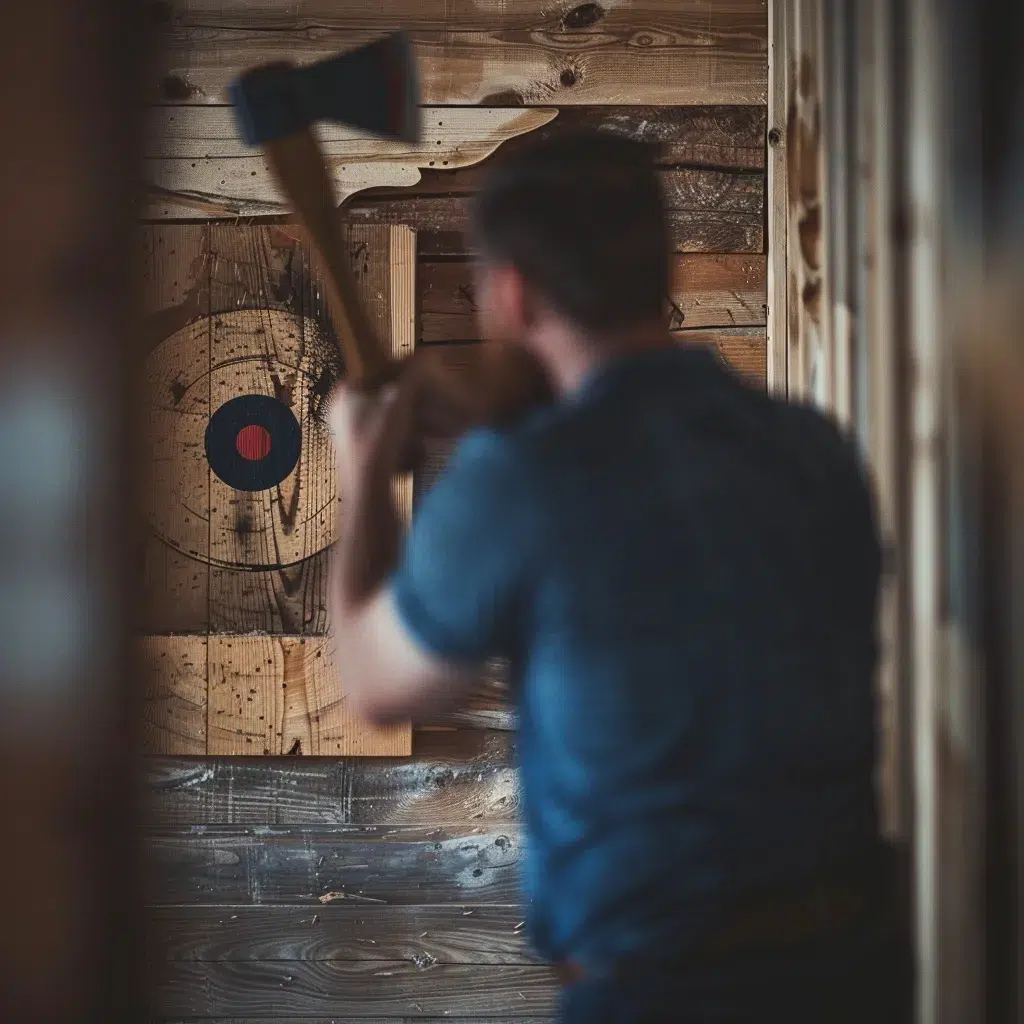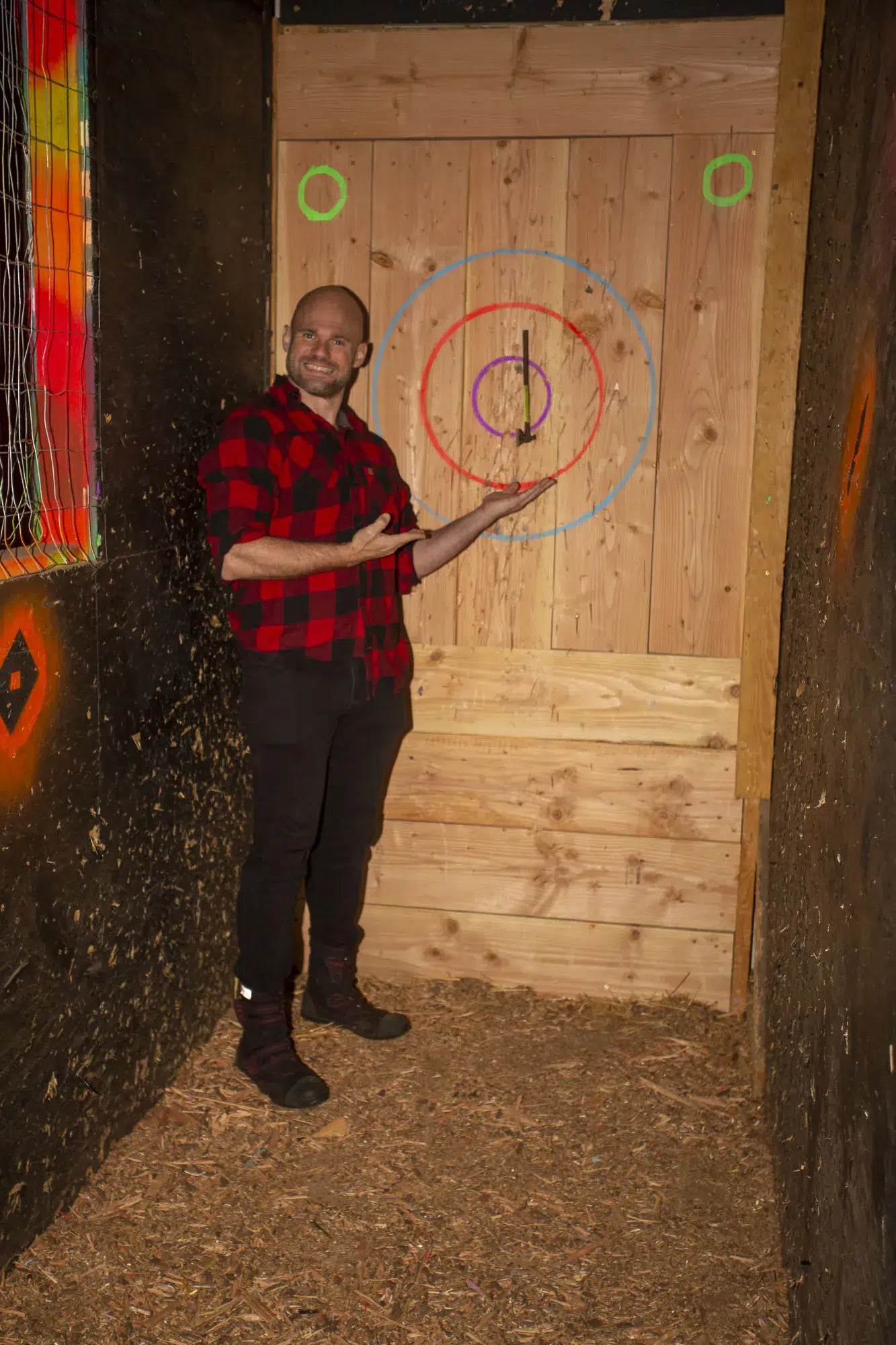Axe throwing is more than just a fun activity; it’s a competitive sport that requires skill and strategy. Did you know that understanding axe throwing points can significantly boost your score in tournaments and playoffs? This article will cover essential techniques for increasing your score, strategies to improve your skills, and common mistakes to avoid. By learning these concepts, readers can confidently enhance their performance and sign a waiver. Whether aiming for personal satisfaction or competitive success, this guide will help tackle the challenges of mastering axe throwing.
Key Takeaways
- Understanding scoring zones helps improve aim and overall performance in axe throwing
- Practicing regularly enhances technique, accuracy, and confidence during competitions
- Proper grip and stance are vital for maintaining balance and control while throwing
- Choosing the right axe type influences performance and scoring success
- Analyzing throws reveals patterns, helping players adjust their techniques for improvement
Understanding Axe Throwing Points and Scoring System

Axe throwing scoring is defined by specific zones on the target that players must aim for. Understanding these zones is key to improving gameplay. Aim and accuracy are significant in determining scores, making practice essential. Furthermore, targets vary in design and weight, affecting the throwing technique. A referee oversees the game, ensuring fair play and accurate scoring.
Overview of Scoring Zones
The scoring zones on an axe-throwing target are crucial for any player looking to improve. These zones, clearly marked for precision, reward players for hitting specific areas with their hatchet. Understanding the layout, as outlined by the World Axe Throwing League (WATL), helps minimize faults and maximize scores, enhancing the overall experience while participating in a rewards program or competition.
Importance of Aim and Accuracy
Aim and accuracy are vital for anyone looking to excel in axe throwing. A competitor’s ability to strike the bullseye consistently can make the difference between victory and a tie. Mastering the fundamentals of aiming at the designated scoring zones on the wooden target boosts confidence and enhances overall performance during competitions.
- Understanding the scoring zones is essential for improving the aim.
- Consistent practice helps develop accuracy and technique.
- Hitting the bullseye can lead to higher scores and greater success.
Differences Between Targets
The differences between axe throwing targets can significantly impact gameplay and performance. Targets vary in size, weight, and materials, affecting how an axe travels and sticks upon impact. Players should practice on different targets to understand how these variations influence their aim and technique, ultimately improving their overall accuracy in competitions.
Essential Techniques for Increasing Score

Several key techniques can boost scores in axe throwing. Proper grip and stance lay the foundation for a successful throw. Understanding the throwing motion is crucial for consistency while adjusting for distance and angle helps players adapt to different targets. Each of these aspects significantly impacts performance and accuracy.
Proper Grip and Stance
Having the right grip and stance is essential for anyone looking to improve their axe throwing scores. A firm but relaxed grip on the axe helps maintain control throughout the throw. Additionally, positioning the feet shoulder-width apart and slightly bending the knees creates a balanced stance, ensuring stability as the player prepares to throw. These fundamentals enhance aim and accuracy, increasing the chances of hitting higher-scoring zones:
- Maintain a firm yet relaxed grip on the axe.
- Stand with feet shoulder-width apart for balance.
- Bend the knees slightly to improve stability.
Focus on the Throwing Motion
Focusing on the throwing motion is crucial for improving scores in axe throwing. A smooth and consistent motion helps players deliver the axe accurately towards the target. Practicing the right technique by starting low and following through with the throw allows for better control and precision, making it easier to hit higher-scoring zones consistently.
Adjusting for Distance and Angle
Adjusting for distance and angle is essential for improving axe throwing scores. Players must consider how far away they stand from the target and the angle at which they throw the axe. For example, a closer distance may require a gentle throw, while a farther distance might call for a more forceful motion. Practicing with various distances helps players understand how these factors influence the axe’s trajectory, leading to more consistent hits in the scoring zones.
Strategies to Improve Axe Throwing Skills

Practicing consistency and form is vital for improving axe throwing skills. This section will discuss techniques to develop a reliable throwing style and the benefits of using visualization techniques to prepare for each throw mentally. Additionally, analyzing throws for improvement will help players identify areas for growth and adjust their techniques for better results.
Practicing Consistency and Form
Practicing consistency and form is essential for anyone wanting to improve their axe throwing skills. Focusing on a regular routine helps refine techniques, making each throw more reliable and accurate. A player can benefit from recording their throws to identify patterns and areas needing adjustment, ultimately leading to better performance and higher scores:
- Implement a regular practice routine to build muscle memory.
- Record and review throws to spot areas for improvement.
- Focus on maintaining a stable grip and stance throughout each throw.
Using Visualization Techniques
Using visualization techniques can greatly enhance a player’s axe-throwing skills. By mentally envisioning each throw, from the grip to the release, the competitor can improve focus and confidence. For example, picturing the axe hitting the bullseye boosts morale and cultivates a strong mindset geared towards success in competitions.
Analyzing Throws for Improvement
Analyzing throws for improvement is a vital step in mastering axe throwing skills. By reviewing recorded throws, players can spot patterns in their technique, such as grip, stance, and follow-through, which could affect their accuracy and scores. This process allows players to identify specific areas for growth, ultimately leading to more consistent and successful throws during competitions:
- Record throws to identify patterns.
- Focus on correcting issues with grip and stance.
- Adjust techniques based on analysis for better performance.
Common Mistakes to Avoid in Axe Throwing

Incorrect body positioning can lead to poor throws and lower scores. Overthinking each throw often causes hesitation, negatively impacting performance. Additionally, underestimating the target might result in missed opportunities to score. Each of these mistakes can hinder progress in mastering axe throwing. Understanding and correcting these errors will help players improve their techniques and boost their overall success.
Incorrect Body Positioning
Incorrect body positioning can significantly impact an axe thrower’s performance. Standing too stiff or improperly aligning the feet reduces balance and accuracy, making it harder to hit the target effectively. To improve their technique, players should adopt a relaxed stance with feet shoulder-width apart and a slight bend in the knees, ensuring they have a solid foundation for each throw.
Overthinking the Throw
Overthinking the throw can undermine a competitor’s performance in axe throwing. When a player becomes too focused on every little detail, it can lead to hesitation, causing throws to become inconsistent. To counter this, players should practice moving through their established techniques smoothly, allowing muscle memory to take over and promoting a more relaxed throwing style that improves accuracy and confidence.
Underestimating the Target
Underestimating the target can lead to missed chances when axe throwing. Many throwers may not recognize the challenge posed by different zones on the target, which can affect their approach to each throw. By fully understanding the target’s layout and setting realistic expectations for their performance, competitors can enhance their focus and increase their potential to score higher points.
Equipment Considerations for Mastery

Choosing the right axe is crucial for mastering axe throwing points. Different axe types affect performance, influencing throw accuracy and distance. Understanding these variations allows players to select an appropriate axe for their skill level. Maintaining and caring for the axe also ensures it performs well over time, enhancing the overall throwing experience.
Choosing the Right Axe
Choosing the right axe is essential for mastering axe throwing points. A player should consider factors such as the weight and length of the axe, as these can significantly affect throw accuracy and control. For example, a lighter axe may be easier for beginners to handle, while a heavier axe can provide better momentum for experienced throwers. Selecting an axe that fits one’s style and skill level can greatly enhance performance and increase the chances of hitting the target consistently.
Understanding Axe Types and Their Impact on Performance
Understanding the different types of axes is essential for enhancing performance in axe throwing. Each axe type has unique characteristics that can influence throw accuracy and control. For instance, a shorter axe might offer greater maneuverability for beginners. In comparison, a longer axe could provide more stability and force for seasoned throwers, catering to various skill levels in the sport.
Conclusion
Mastering axe-throwing points is essential for achieving success in the sport. To improve their performance, players must understand scoring zones, refine their techniques, and maintain their equipment. Consistent practice, proper body positioning, and mental strategies further enhance accuracy and confidence. Throwers can significantly boost their scores and enjoy a competitive edge by focusing on these key elements.

